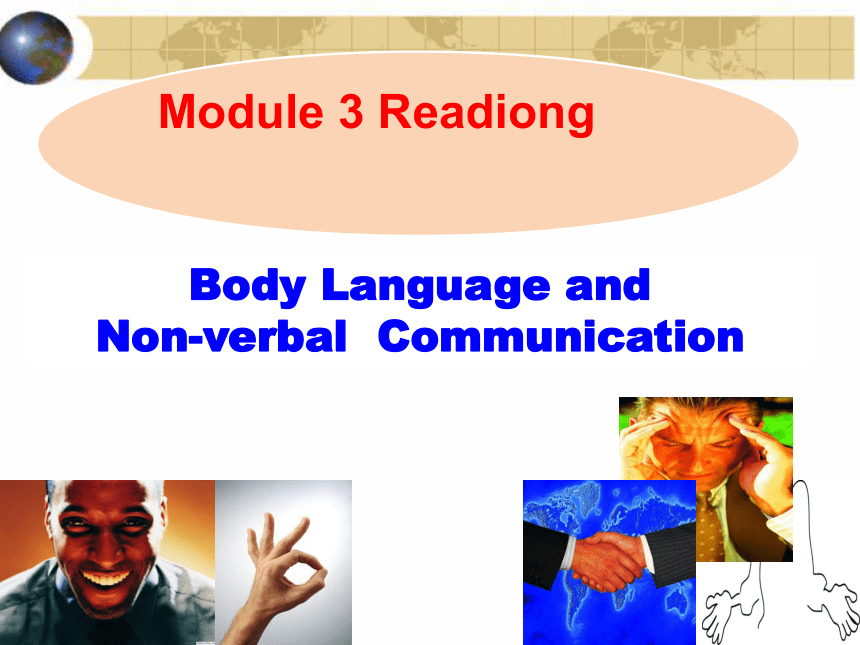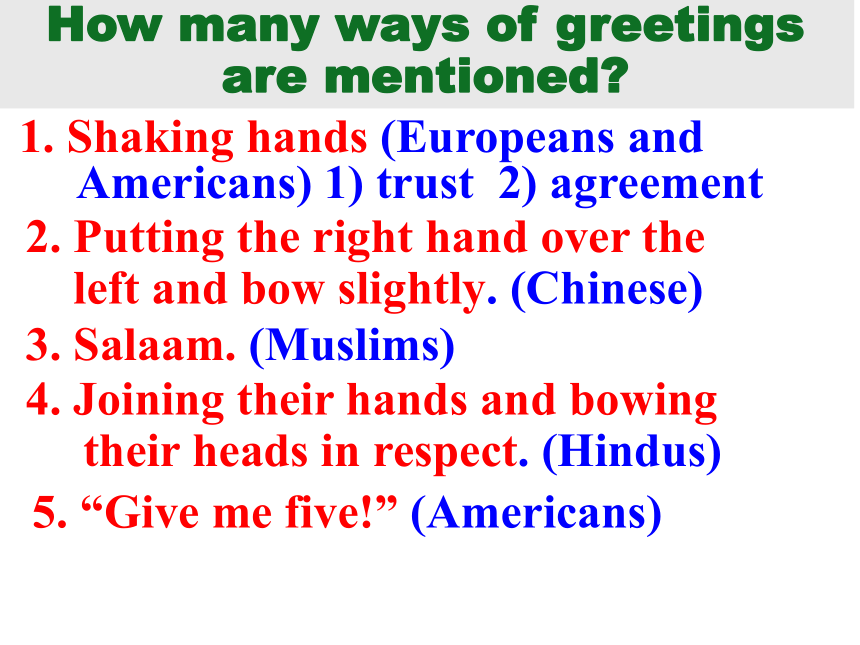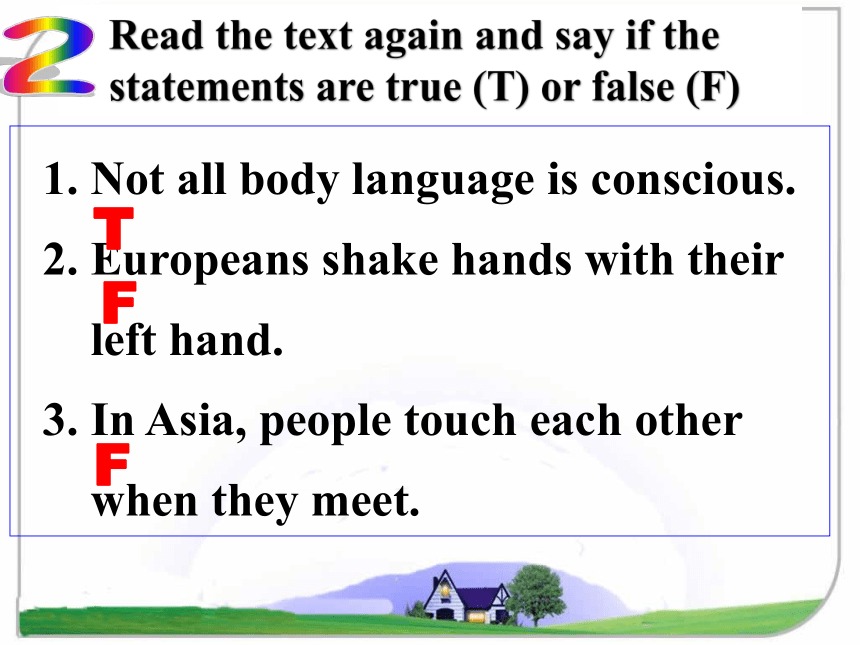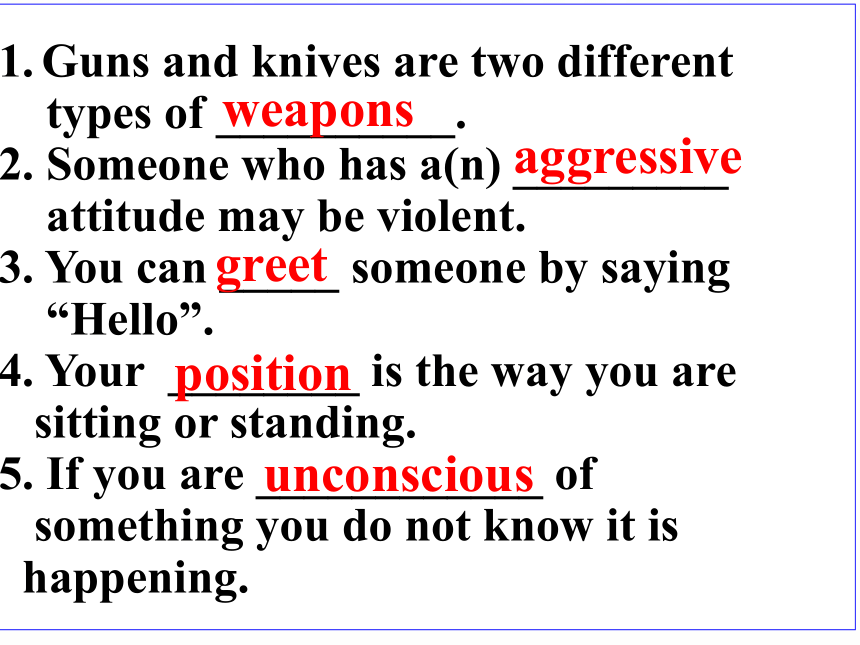外研版Module 3 Body Language and Non-Verbal Communication Reading课件(共18张PPT)
文档属性
| 名称 | 外研版Module 3 Body Language and Non-Verbal Communication Reading课件(共18张PPT) |  | |
| 格式 | zip | ||
| 文件大小 | 673.7KB | ||
| 资源类型 | 教案 | ||
| 版本资源 | 外研版 | ||
| 科目 | 英语 | ||
| 更新时间 | 2018-12-03 21:19:30 | ||
图片预览







文档简介
课件18张PPT。Module 3 Readiong
Body Language and
Non-verbal CommunicationFast Reading Read the passage and choose the best title.
Saying It Without Words
When in Rome, Do as the Romans do
Greeting Around the World
Read My Mind
How many ways of greetings
are mentioned?1. Shaking hands (Europeans and Americans) 1) trust 2) agreement2. Putting the right hand over the
left and bow slightly. (Chinese)3. Salaam. (Muslims)4. Joining their hands and bowing their heads in respect. (Hindus)5. “Give me five!” (Americans) 1. Not all body language is conscious.
2. Europeans shake hands with their
left hand.
3. In Asia, people touch each other
when they meet.FTFRead the text again and say if the statements are true (T) or false (F)24. In the US a “high five” is a way of
saying hello.
5. A “high five” is a formal gesture.
6. Body language is less communicative
than spoken or written language.TFF Complete the
sentences with the words given.aggressive deal gesture formal trust informal position unconscious weapon3
Guns and knives are two different
types of __________.
2. Someone who has a(n) _________
attitude may be violent.
3. You can _____ someone by saying
“Hello”.
4. Your ________ is the way you are
sitting or standing.
5. If you are ____________ of
something you do not know it is
happening.weaponsaggressivegreetpositionunconscious
6. A(n)_____ is a business agreement.
7. A(n) _______ is a movement of the
body to communicate something.
8. If you _____ someone you believer
them and rely on them.
9. “Give me five!” is a(n) _________
greeting.
10. People are usually more _______
with people they don’t know.dealgesturetrustinformalformalKey sentences1.尽管这些很重要, 但我们并不只是通过口头和书面语言交流。.
Although these are very important, we communicate with more than just spoken and written words.2. 我们经常看到无意识的身势语,
但也有“习得”的身势语。习
得的身势语因文化差异而不同。
We see examples of unconcious body
language very often, yet there is also
"learned" body language, which
varies from culture to culture.
3. 实际上,身体的姿势是我们所
称的“身体语言”的一部分。
Indeed, body positions are just
part of what we call “body
language”.
4.跟其他动物一样,只有在感觉很安全时我们才会放松,否则将一直处于戒备状态。
Like other animals, we are on guard
until we know it is safe to relax.
5. 假如右手正忙着与人打招呼,
就不可能用它来拿武器了。 If our right hand is busy greeting
someone, it cannot be holding a
weapon.
6.亚洲人打招呼是不接触他人的, 但
他们要用手。
Greetings in Asian countries do
not involve touching the other
person, but they always involve
the hands.7. 穆斯林行额手礼,用手触胸,
嘴,和额。 Muslims give a “salaam”,
where they touch their heart,
mouth and forehead. 8.印度人双手交合,恭敬的鞠躬。 Hindus join their hands and
bow their heads in respect.
9. 然后一个人举起手,手掌向外,
五指展开。 One person holds up his hand,
palm outwards and five fingers
spread. 10.人们通过姿势表达的意思要比通过话语表达得更多。 People give away much more by
their gestures than by their words.
Body Language and
Non-verbal CommunicationFast Reading Read the passage and choose the best title.
Saying It Without Words
When in Rome, Do as the Romans do
Greeting Around the World
Read My Mind
How many ways of greetings
are mentioned?1. Shaking hands (Europeans and Americans) 1) trust 2) agreement2. Putting the right hand over the
left and bow slightly. (Chinese)3. Salaam. (Muslims)4. Joining their hands and bowing their heads in respect. (Hindus)5. “Give me five!” (Americans) 1. Not all body language is conscious.
2. Europeans shake hands with their
left hand.
3. In Asia, people touch each other
when they meet.FTFRead the text again and say if the statements are true (T) or false (F)24. In the US a “high five” is a way of
saying hello.
5. A “high five” is a formal gesture.
6. Body language is less communicative
than spoken or written language.TFF Complete the
sentences with the words given.aggressive deal gesture formal trust informal position unconscious weapon3
Guns and knives are two different
types of __________.
2. Someone who has a(n) _________
attitude may be violent.
3. You can _____ someone by saying
“Hello”.
4. Your ________ is the way you are
sitting or standing.
5. If you are ____________ of
something you do not know it is
happening.weaponsaggressivegreetpositionunconscious
6. A(n)_____ is a business agreement.
7. A(n) _______ is a movement of the
body to communicate something.
8. If you _____ someone you believer
them and rely on them.
9. “Give me five!” is a(n) _________
greeting.
10. People are usually more _______
with people they don’t know.dealgesturetrustinformalformalKey sentences1.尽管这些很重要, 但我们并不只是通过口头和书面语言交流。.
Although these are very important, we communicate with more than just spoken and written words.2. 我们经常看到无意识的身势语,
但也有“习得”的身势语。习
得的身势语因文化差异而不同。
We see examples of unconcious body
language very often, yet there is also
"learned" body language, which
varies from culture to culture.
3. 实际上,身体的姿势是我们所
称的“身体语言”的一部分。
Indeed, body positions are just
part of what we call “body
language”.
4.跟其他动物一样,只有在感觉很安全时我们才会放松,否则将一直处于戒备状态。
Like other animals, we are on guard
until we know it is safe to relax.
5. 假如右手正忙着与人打招呼,
就不可能用它来拿武器了。 If our right hand is busy greeting
someone, it cannot be holding a
weapon.
6.亚洲人打招呼是不接触他人的, 但
他们要用手。
Greetings in Asian countries do
not involve touching the other
person, but they always involve
the hands.7. 穆斯林行额手礼,用手触胸,
嘴,和额。 Muslims give a “salaam”,
where they touch their heart,
mouth and forehead. 8.印度人双手交合,恭敬的鞠躬。 Hindus join their hands and
bow their heads in respect.
9. 然后一个人举起手,手掌向外,
五指展开。 One person holds up his hand,
palm outwards and five fingers
spread. 10.人们通过姿势表达的意思要比通过话语表达得更多。 People give away much more by
their gestures than by their words.
